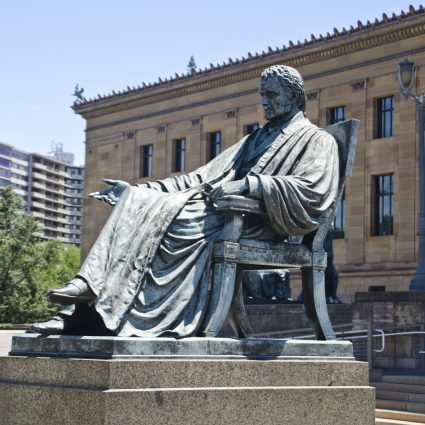At A Glance
Social Consciousness has been relocated from the Philadelphia Museum of Art to the University of Pennsylvania’s campus
Originally commissioned for the Ellen Phillips Samuel Memorial to express the American ideal of compassion
It was clear that the Memorial could not accomodate the massive sculpture as it took shape
Suggests the tenderness and sympathy of humankind and the affliction that makes these virtues necessary
Critics have complained that the figures look unnatural, upholding Epstein’s reputation for controversy

The Eternal Mother, seated with arms outstretched, casts a stern, sorrowful look at passersby on the University of Pennsylvania campus.
But as the massive sculpture took shape, the artist and the Art Association realized that the planned site in the Samuel Memorial could not accommodate the work
Flanking her are two standing female figures: one representing Compassion, reaching down to comfort a stricken youth collapsed at her feet; and another that personifies Succor (or Death), supporting at the hips a young man who bends backward to embrace her shoulders. The entire group by Jacob Epstein suggests not only the tenderness and sympathy of humankind but also the affliction that makes these virtues necessary.
Epstein was one of the first Westerners to develop a deep appreciation of “primitive” and traditional art. He displayed a particular interest in images of maternity and fertility. His career was punctuated by controversy, however, and his public commissions often prompted such adjectives as “ugly,” “vulgar,” and “vile.”

The commission for Social Consciousness was awarded to Epstein in 1950 by the Fairmount Park Art Association (now the Association for Public Art), which wanted to include in the Ellen Phillips Samuel Memorial a work expressing the American ideal of compassion. But as the massive sculpture took shape, the artist and the Association realized that the planned site in the Samuel Memorial could not accommodate the work. Instead, Social Consciousness was installed in 1955 at the West Entrance of the Philadelphia Museum of Art, where it upheld Epstein’s reputation for controversy.
In 2019, Social Consciousness was relocated from the West Entrance of the Philadelphia Museum of Art to the University of Pennsylvania, along the Memorial Garden Walkway near the Van Pelt Library. The sculpture is on long-term loan to the university from the Association for Public Art. It has been placed in a more contemplative site than its previous location, consistent with the artist’s intentions, near works by Alexander Archipenko, Robert Indiana, John J. Boyle, Claes Oldenburg, and Robinson Fredenthal, among others.
Some critics have complained that the figures look unnatural; others have objected to the lack of strong visual unity among the three separate groups. On the other hand, the work has been praised for its amalgamation of Western and Eastern influences and its “hieratic” stylization that suggests a timeless emotion. It could be argued that the very awkwardness of the figures emphasizes the precariousness and suffering of the human condition.
Adapted from Public Art in Philadelphia by Penny Balkin Bach (Temple University Press, Philadelphia, 1992).

Voices heard in the Museum Without Walls: AUDIO program: Penny Balkin Bach is the former Executive Director & Chief Curator of the Association for Public Art (aPA) and the author of many books and articles about public art in Philadelphia. David Hollenberg served as University Architect at the University of Pennsylvania, where the sculpture is now located, from June 2006 through 2020. Evelyn Silber is a Senior Research Fellow at the University of Glasglow and author of The Sculpture of Epstein. | Segment Producer: Dallas Taylor / Rowhome Productions
Museum Without Walls: AUDIO is the Association for Public Art’s award-winning audio program for Philadelphia’s outdoor sculpture. Available for free by phone, mobile app, or online, the program features more than 150 voices from all walks of life – artists, educators, civic leaders, historians, and those with personal connections to the artworks.
RESOURCES
- Penn Today: Two monumental sculptures arrive on campus
- Philadelphia Inquirer: Art Museum sculptures that have stood sentry for decades are moving to Penn for 99 years
- How to Request Images
- The Association for Public Art’s Digital Archive
This artwork is part of the Around University City tour



